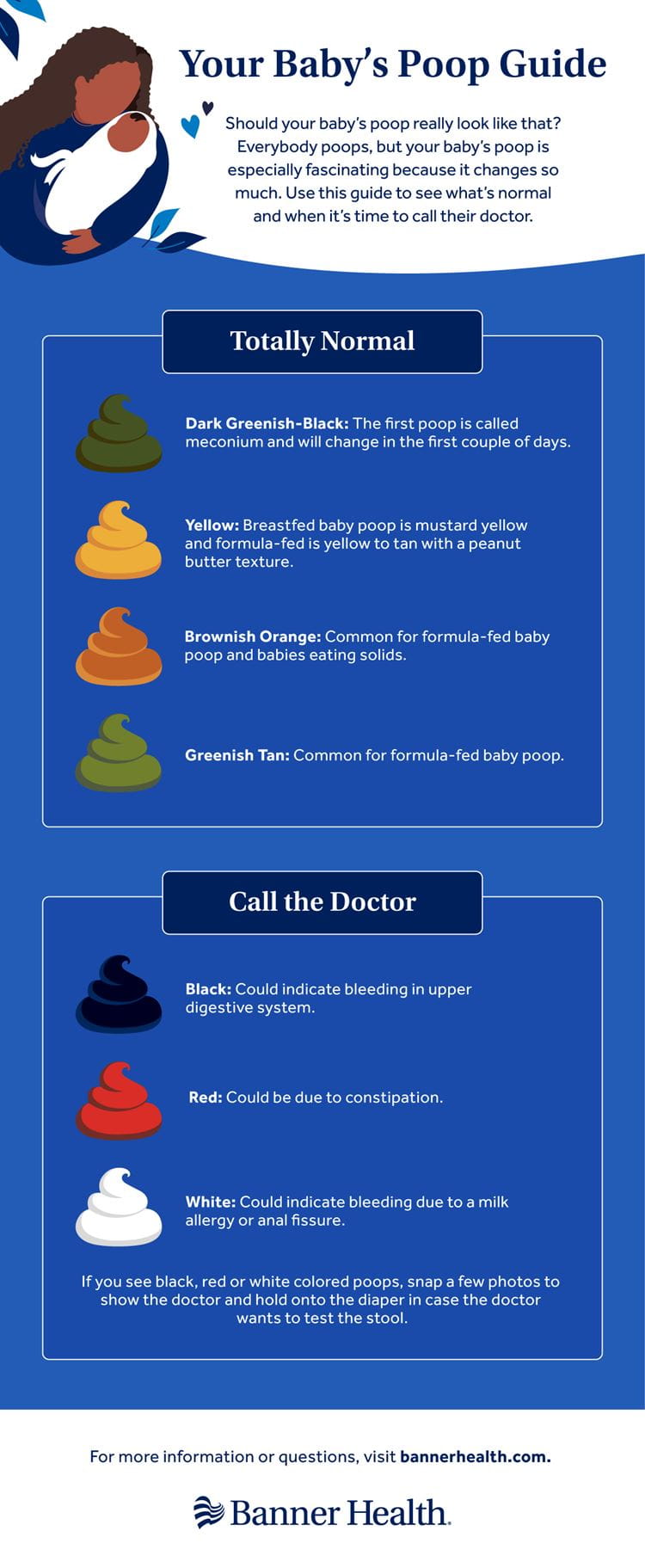When Will My Babies Poop Not Be Seedy
Everyone poops, but your baby'southward poop is particularly fascinating—especially in the first few months of life. You haven't inverse enough diapers, if you oasis't gasped or said, "Woah!" at least once while opening up your babe's diaper. The range of colors, consistency, size and smells, it's no wonder it becomes a mutual topic of word between parents and with a child'due south primary care provider.
There's practiced reason to intendance a lot about your baby'southward poop though. That's because your babe's poop can tell yous a lot well-nigh their health and development.
"It'due south important to keep track of the number of poops and color during the first few days and weeks of life as that helps your pediatrician understand how your baby is eating and growing," said Helene Felman, MD, a pediatrician with Diamond Children'south Multispecialty Services Dispensary in Tucson, AZ. "If a babe is pooping regularly, we know they are eating regularly, and growing commonly."
While every diaper change may uncover a new surprise, y'all may wonder what is normal and what's non in the baby poop department. Dr. Feldman helped breakdown what to look.
The evolution of infant poop: How poops change every bit baby grows
Newborn poop
The first type of poop your babe will have is called meconium. It'll await dark, pasty and tarry and will be difficult to make clean off. After 24 to 48 hours, it will transition to xanthous and seedy. Think fancy mustard, like Grey Poupon—no pun intended!
Breastfed poop
Breastfed babies have the most variety in frequency of poops but the color and consistency are typically soft, polish and mustard-like. It's more of a puree consistency than a kid or adult-type poop. Breastfed babies typically poop after each feeding, but the frequency can get down equally they get older. As long as the poop is soft, and not hard assurance, it's not constipation.
Formula-fed poop
Formula-fed babies tend to have slightly more solid poops, still soft, and occur about one to three times daily. The color also tends to be darker xanthous, brownish or dark-green.
Afterwards introducing solids
In one case babies starting time eating solid foods, around age 6 months, regardless if they're breastfed or formula-fed, their stools volition become more solid and formed. Every bit long as they aren't producing difficult balls, this is normal and not constipation.
Why colour matters when it comes to your baby's poop
While colors like green, night brown or yellow poops are peculiar, there are really only three colors Dr. Feldman said you should worry about: black, white and red.
"Dark-green, orange, yellow, brownish and everything in betwixt are typical for babies," Dr. Felman said. "Brown and orange are more than typical for formula-fed babies, but tin occur in breastfed babies besides. The colors of stool for a breastfed baby tin likewise alter based on their mother'south nutrition. Only if you encounter scarlet, blackness or white stools, telephone call your baby's medico right away."
- Black poops: Information technology could indicate older blood in stool.
- White poops: It could be a sign your baby'southward liver isn't working as it should.
- Red poops: Many times, it could indicate haemorrhage. It may appear stringy or mucous-like and could be a upshot of a milk allergy or anal fissures.
"If y'all come across whatsoever of these three colors, snap a few photos to evidence the physician and hold onto the diaper in case the doc wants to test the stool," Dr. Felman said.
For a quick cheat sheet, check out our Babe Poop Guide below:

Is my baby constipated?
Many parents worry almost their baby straining and turning red in color when they are passing poop, but as long equally the stools are soft and normal in color, don't worry. According to Dr. Felman, "This happens so often, at that place is even a medical term for it: infant dyschezia."
"I ask parents, 'Accept you ever tried pooping while lying down?' It's hard to move stool from that position," Dr. Felman said. "You tin help your infant pass their poops by massaging their stomachs and bicycling their legs to assist put force per unit area on their abdomen and push the poop out more than easily that manner."
Though not an emergency, if your baby hasn't pooped in iv days, talk to the nurse or md to encounter if there are things you can endeavor to aid your baby pass the poop.
The takeaway
Your baby'due south poop volition be a topic of conversation their first few years of life, only it's for practiced reason. Their poop volition fluctuate quite a bit every bit they abound and get-go eating solids. While most colors and textures are normal, if yous're ever concerned about your baby's bowel movements, don't hesitate to telephone call your doctor for communication.
For other parenting tips, cheque out:
- 4 Common Causes for Your Child's Tummy Ache
- Birth to Five Years: Knowing Your Child'due south Developmental Milestones
- Rashes on Children: When Should I Worry?
Join the Conversation
Source: https://www.bannerhealth.com/healthcareblog/teach-me/baby-poop-what-is-normal-and-what-is-not

0 Response to "When Will My Babies Poop Not Be Seedy"
Post a Comment